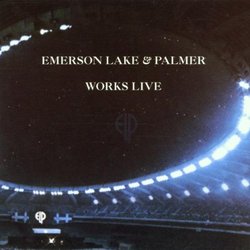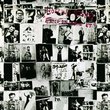| All Artists: Emerson Lake & Palmer Title: Works Live Members Wishing: 0 Total Copies: 0 Label: Castle Music UK Release Date: 3/10/1996 Album Type: Import Genres: Pop, Rock, Classic Rock Styles: Progressive, Progressive Rock, Album-Oriented Rock (AOR) Number of Discs: 2 SwapaCD Credits: 2 UPC: 501761583622 |
Search - Emerson Lake & Palmer :: Works Live
 | Emerson Lake & Palmer Works Live Genres: Pop, Rock, Classic Rock
|
Larger Image |
CD DetailsSimilar CDs
|
CD ReviewsELP's proper farewell to the 1970s Eddie Konczal | 07/07/2005 (4 out of 5 stars) "An air of melancholy and finality always haunted "In Concert" (1979), the last of three live albums that progressive rock supergroup Emerson Lake & Palmer released during the 1970s. It lacked most of ELP's signature songs from the early 1970s, suffered from lackluster production values, and always paled next to 1974's "Welcome Back My Friends To The Show That Never Ends...", a triple live LP now available as a 2 CD set. Progressive rock's critics seized upon the relative briefness of "In Concert" - and the truncated tour it documented - as emblematic of ELP's decline. But the CD era brought new life to this formerly moribund collection. "Works Live" expands "In Concert" to a double CD, giving ELP's late-70s period a live record worthy of its output. All the tracks from "In Concert" are here: a spirited rendition of the "Peter Gunn" theme; a surprisingly energetic "Tiger in a Spotlight;" the exquisite Greg Lake ballad "C'est La Vie;" a boisterous adaptation of Prokofiev's "The Enemy God Dances with the Black Spirits;" and a magnificent, 15-minute condensation of ELP's adaptation of Mussorgsky's "Pictures at an Exhibition." I actually (and somewhat heretically) prefer this focused version of "Pictures" to the longer, sloppier version on the earlier album of the same name (1972). Unfortunately, the remastering job didn't help "Knife-Edge" and "Piano Concerto No. 1," two tracks that still suffer from lo-fi mixes. To the original "In Concert" set, "Works Live" adds seven tracks, most of them from ELP's two "Works" albums that this tour (which featured a full orchestra) supported. Of the added tracks, "Abaddon's Bolero" and "Fanfare for the Common Man" benefit the most from orchestral accompaniment (the latter sounding particularly majestic with live trumpets). "Watching Over You" and "Closer to Believing" further demonstrate Lake's considerable talent for balladry. "Maple Leaf Rag" and "Show Me the Way to Go Home," admittedly minor entries in the ELP oeuvre, add diversity to the proceedings. A twelve-minute "Tank," complete with Carl Palmer drum solo, provides a grand finale. "Works Live" represents ELP's proper farewell to the 1970s in a way the abbreviated "In Concert" failed to do. It effectively captures the ambition of ELP's "Works" albums and tour, warts and all." If Only the 24-Track Hadn't Broken Down... JESSE R. MC Glown | Enterprise, AL | 12/12/2003 (3 out of 5 stars) "That's the reason for the 'flat' sound on the majority of this recording...most of the Montreal Works '77 show was recorded on a two-track machine out at the board ( due to the multitrack recorder having failed on location, according to Keith Emerson ). Listen to the difference in sound quality between "Knife-Edge", "Fanfare", "Pictures"...and "Peter Gunn", "Tiger in a Spotlight", etc ( the latter ones from multitrack mixes done at a different venue, regardless of what this CDs liner notes claim ). They did the best they could to salvage this show for posterity, which was the PA mix feed going into the 2-track ( hence the predominantly mono sound on those cuts ). What baffles me, after all these years, is that they obviously went to the trouble to have professionally recorded at least one other concert, sans orchestra ( Wheeling, West Virginia, according to the King Biscuit CD liner notes ). I'm convinced that multitrack versions of Tarkus, Hoedown, Pictures, Nutrocker exist from 1977...why they didn't go back to these tapes for the "fleshing out" of this album is simply beyond me. While I'm indulging in speculation, for that matter, why didn't they opt for recording with the orchestra during the three nights at Madison Square Garden instead? Might have been able to get another 24-track out to the venue, at least to have recorded the remaining one or two shows...ah, what could have been!" A Good, but Sad Album Anthony Guidice | Rochester, NY United States | 09/13/2003 (1 out of 5 stars) "First of all, I believe some of the recordings on the first side, where the band plays as a trio (without orchestra) were not recorded in Montreal, but in West Virginia in November, 1977! Very odd that these recordings would be included, and orchestrated versions of The Enemy God, Pirates, among others; would be left out...?I saw ELP in New York with the orchestra in July, 1977... it was a strange show. Very good, but not quite ELP. I never liked the shortened version of "Pictures". In NYC "Tarkus" was shortened also, though Tarkus is not on this CD. In NYC, it was obvious the band was having trouble, and that was a bit sad.This album is sad too. You can perceptively feel difficulty and strain. The music is good - they hit all the notes and the orchestra sounds good; but the (then) confirmed idea that this huge tour was a big mistake seems palpable. All of them - Emerson, Lake and Palmer - seem to have a collective broken heart. I was struck by this fact when I first heard it.I also agree with a previous reviewer who wonders why they didn't release music from the entire concert. Why put the 3 piece stuff in there from West Virginia? ...and why leave Pirates out? ... it sounded very fine live in NYC, and it was probably the best ELP piece with the orchestra. Bewildering. Probably the record company's idea... makes those of us who didn't make music a career glad we didn't I guess.This CD is worth having, particularly if you know the history behind it. It's a good reminder to any artist to always try and do the impossible. But "Works Live" seems somehow filled with melancholy. It has none of the exuberance of the 1975 "Welcome Back..." live album. No doubt odd that an album like this could have an undercurrent of regret and disappointment in it, but it does."
|

 Track Listings (10) - Disc #1
Track Listings (10) - Disc #1
